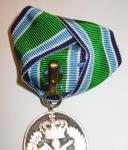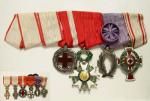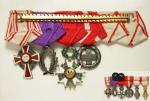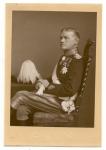-
Posts
1,232 -
Joined
-
Last visited
-
Days Won
9
Content Type
Profiles
Forums
Blogs
Gallery
Events
Store
Everything posted by Great Dane
-

Denmark Danish General Anders Gjedde Nyholm
Great Dane replied to mravery's topic in Northern European & Baltic States
There are a few copies of the Silver Merit Crosses out there, but so few that they were probably made as replacement pieces rather than made to deceive. And the ones I've seen are very easy to distinguish from the real thing. So unless some very good copies exist (which I don't believe) yours is as genuine as they come. If you're unsure of specific details on the cross, you're welcome to mail me (PM or here) detailed pictures of it. Tomorrow is a national holiday here, so the libraries are closed (talk about lack of logic...), but I'll try to go there on Saturday and do some more research. You'll have to live with the suspense until then /Mike -

Denmark Danish General Anders Gjedde Nyholm
Great Dane replied to mravery's topic in Northern European & Baltic States
Brian, It's very easy to list the amount of Austrians who received this cross: The Silver Merit Cross was reserved for Danes only (unless you were Royalty related to the King...) /Mike -

Denmark Danish General Anders Gjedde Nyholm
Great Dane replied to mravery's topic in Northern European & Baltic States
Mark, Without having the actual piece in hand, I'd say it looks OK. Danish ribbon style evolved over time. In the 19th century a straight ribbon was normally used, but towards the end of the century the trifold ribbon became very popular (probably copied after Austrians). Even Christian IX himself wore his Dannebrog Silver Merit Cross on a trifold ribbon (although the cross had a different cypher than yours). Shortly after the turn of the century the current 'trifold' style became standard (although - as I already mentioned - the decision of which part should be on top of the other was changed around 1910-20). /Mike -

Denmark Danish General Anders Gjedde Nyholm
Great Dane replied to mravery's topic in Northern European & Baltic States
Mark, My 3 piece medal bars are all with a 7 cm hinge and the 2 piece bars with a 5 cm hinge, so I guess that combination would fit (give or take a bit...) /Mike -

Denmark Danish General Anders Gjedde Nyholm
Great Dane replied to mravery's topic in Northern European & Baltic States
Czar Nicolaus II Dannebrog Silver Merit Cross was the Christian IX version (awarded 11. Sept. 1891) /Mike -

Denmark Danish General Anders Gjedde Nyholm
Great Dane replied to mravery's topic in Northern European & Baltic States
Under the heading "Ordensnachla? eines Kommerzienrat". EDIT: Darn, you were too fast /Mike -

Denmark Danish General Anders Gjedde Nyholm
Great Dane replied to mravery's topic in Northern European & Baltic States
Allow me to correct you: Czar Nicolaus II is always wearing his Dannebrog Silver Merit Cross (he was also Knight of the Order of the Elephant and Grand Commander of the Order of Dannebrog). Grand Commander is a special class reserved for royalty. /Mike -

Denmark Danish General Anders Gjedde Nyholm
Great Dane replied to mravery's topic in Northern European & Baltic States
Zeige has an Oldenburg Offizierskreuz (lot 8) in the forthcoming auction on May, 26th, but it seems to be connected to the award document in lot 9 (or am I wrong in my assumption here?) and it would be a real shame to split them. There is also an Offizierskreuz with swords in lot 78. Next big question: Was Nyholm awarded the version with or without swords? Zeige Auction /Mike Lot 8 and 78: -

Denmark Danish General Anders Gjedde Nyholm
Great Dane replied to mravery's topic in Northern European & Baltic States
Brian, No Silver Merit Cross I have seen has been marked and only some Knight Crosses. Most (all?) Commander badges are marked - at least the gold ones. Mark, Well, your guess is as good as mine (yours is probably better when it comes to uniforms... ), but your suggestion seems plausible. /Mike -

Denmark Danish General Anders Gjedde Nyholm
Great Dane replied to mravery's topic in Northern European & Baltic States
Mark, Allow me to correct myself: Browsing through my books of Danish Navy officers, there actually are examples of officers wearing their medal bars in two rows, where the badges of the top row cover the ribbons of the bottom row (what I call 'french style'). Also, placing Commander awards along the right side buttons is more common than I thought... /Mike -

Denmark Danish General Anders Gjedde Nyholm
Great Dane replied to mravery's topic in Northern European & Baltic States
Mark, I can only answer for the Danish awards, so someone else will have to help with the others. The Frederik VIII Silver Cross is very hard to find and will cost you $1500-$2000. If you want a filler, the cheapest one is the Christian X version, which can be found for approx. $500. Actually $550 is not a bad price for a Christian IX version. A Christian X Commander set will cost you $2000-$2500. The Christian X version is actually the cheapest version, but the price will vary depending on the badge being gold or silvergilt. The Breast Crosses have changed a bit over the years (3 official models - last one from approx. 1960) but the differences are small. Note that the Breast Crosses do not have any royal cypher, so in that sense they are 'generic'. For the other awards, I think the Russian St. Anne, the Oldenburg Offizierskreuz and the Mecklenburg Greifen Order will be the most expensive ones. /Mike -

Denmark Danish General Anders Gjedde Nyholm
Great Dane replied to mravery's topic in Northern European & Baltic States
Brian, Yes, I'm sure economical reasons played a big part in the return policy, but I guess it was also a matter of continuing the tradition from when the order was instituted in 1671. Frederik VI changed the order to a multi-class order and opened it to a wider audience resembling the French Legion d'Honneur (we were allied with Napoleon back then). When Frederik VI died it was decided to change the appearance of the order as a tribute to him. The reverse now contained his name 'Fr.VI' on the upper cross arm and the year of his change (1808) was moved to the lower cross arm. So no crosses from his reign were re-cyphered, but from Christian VIII and onwards crosses were reused. Even today you can be awarded a cross from the Christian VIII period (1839-48) with the cypher of Margrethe II. Unlike the enamelled crosses which had some small adjustments to the design around the beginning of the 20th century, the Silver Cross has kept it's appearance. /Mike -

Denmark Danish General Anders Gjedde Nyholm
Great Dane replied to mravery's topic in Northern European & Baltic States
The recipient would continue to wear his award with the cypher of the King it was awarded under. Of course if he was promoted from, say, Knight to Commander the Commander badge would have the cypher of the new King and the Knight badge would be returned. Hmm... I'm definitely not an expert on uniforms so my only guesses are that his latest medal bar goes through the 8 cm loops. Maybe an earlier bar used the 5.5 cm loops which are in a more correct position according to regulations. Then, after receiving som Commander awards, he felt he had to put his medal bar in a higher position to match the Commander awards on the right breast. I doubt both loop pairs were used at the same time - I have never seen any Danish officer wearing his medals 'french style'. I would suggest his Dannebrog Commander Breast Star (actually it's a Cross) goes in the most prominent position using the 5.5 cm vertical loops (the distance between the hinge and the hook is actually 5.5 cm), and maybe the small Oldenburg Offizierskreuz would use the 2.5 cm loops. The loops along the right side buttons may have been used for other Commander badges. I know that Hussars are allowed to place them there, but I don't know about others (or maybe he just felt it looked better to put them there). /Mike -

Denmark Danish General Anders Gjedde Nyholm
Great Dane replied to mravery's topic in Northern European & Baltic States
Mark, A note about finding the Frederik VIII Silver Merit Cross: Remember that all orders was/is to be returned upon the death of the recipient. They would then be re-cyphered (i.e. the 'F R VIII' cypher under the crown would be replaced by a newer cypher) and awarded again. This means that early specimens are not just hard to find because they are old, but very hard to find because they are old and removed from circulation... To give you an idea of the no. of Silver Merit Crosses awarded, I have listed some of them here: Christian IX (1863-1906): ~7000 Frederik VIII (1906-1912): ~1700 Christian X (1912-1947): ~12000 During the 2. Danish-Prussian war in 1864 the Silver Merit Cross was used as a decoration for bravery, hence the high number for Christian IX. Frederik VIII only reigned for 6 years, so they are very hard to find. /Mike -

Denmark Danish General Anders Gjedde Nyholm
Great Dane replied to mravery's topic in Northern European & Baltic States
The length of the pin on the medal bar shown is 15 cm, but remember this is a 6 medal bar. The medals are attached to a hook sewn onto the back ribbon. I have 'pulled apart' a medal to show the principle /Mike P.S: Beautiful bar Brian, I remember seeing it in another thread. -

Denmark Danish General Anders Gjedde Nyholm
Great Dane replied to mravery's topic in Northern European & Baltic States
Sure can (it has of course nothing to do with Nyholm - just an example of the Danish mounting). (in this case the 2 Dannebrog orders have been returned) /Mike -

Denmark Danish General Anders Gjedde Nyholm
Great Dane replied to mravery's topic in Northern European & Baltic States
Not necessarily. Danish bars are fairly simple - if you have the orders on the trifolded ribbon (OK, that could be a challenge for the foreign awards...) it's just a matter of attaching them to a metal thingy. All the Danish mounted bars I have seen is mounted this way (the oldest being from the 1910s). Here is an example: /Mike -

Denmark Danish General Anders Gjedde Nyholm
Great Dane replied to mravery's topic in Northern European & Baltic States
The last one seems to be the Finnish Skyddsk?rernas f?rtj?nstkors. I don't think it has a rosette - I think it's the top tunic button shining through. /Mike -

Denmark Danish General Anders Gjedde Nyholm
Great Dane replied to mravery's topic in Northern European & Baltic States
Hmm... I don't think it's the Anhalt order, because that one is round (or elliptical to be more precise). I have enlarged the medal part of his picture, and in my opinion both order #2 and #4 are crosses with dark enameled cross arms and brighter centers. This could be both the Greifen Order and the St. Anne order... I won't judge it from the ribbon color alone. The ribbon of the Greifen Order is dark yellow (and red edges) which often comes out as dark grey on B/W photos (just look at all the photos of Germans wearing the Wilhelm II Jubilee medal). The ribbon of the Swedish Order of the Sword is a brighter yellow (and blue edges). But anyway, it won't affect your choice of awards for him... /Mike -

Denmark Danish General Anders Gjedde Nyholm
Great Dane replied to mravery's topic in Northern European & Baltic States
Oh, I misunderstood your question about the Commander awards... Regulation states that one is worn around the neck and the rest in a single row similar to the normal medal bar, but on the right side of the chest. The orders on the bar are mounted in a trifolded ribbon similar to knight crosses etc. (just on a wider ribbon). On a double breasted tunic the bar is placed at the upper edge of the button-over part (which is slightly higher that the normal bar on the left side chest). If there are many Commander awards they should overlap slightly. According to regulation the top edge of the normal bar (on the left hand side) on a double breasted tunic should be between the top button and the next button. It looks like Nyholm placed his bar a bit higher... I don't really have any pictures of people wearing that many awards on a double breasted tunic. Probably most multi-decorated recipients chose to wear only some of their awards... /Mike -

Denmark Danish General Anders Gjedde Nyholm
Great Dane replied to mravery's topic in Northern European & Baltic States
I'm not an expert in that order, but I would assume - since he's in the army - that it would be awarded with swords...? Or does the swords on this order represent a war-time award...? /Mike -

Denmark Danish General Anders Gjedde Nyholm
Great Dane replied to mravery's topic in Northern European & Baltic States
The photo wasn't from the library unfortunately. I don't really remember where I got the image (I don't have the actual photo) - maybe from an internet auction somewhere. So I'm afraid this JPG image is all I have (I didn't even reduce the image size before I posted it). Regarding the wearing of breast stars: He didn't end up having that many breast stars - 2 Grand Crosses (Denmark and Belgium), 3 Commander's Crosses (Finland, Italy and Netherlands) and the Oldenburg Offizierskreuz, so they could actually be placed on his left side chest (sometimes the sash would cover some of them). In the special case where a recipient wanted to wear all his stars and couldn't make them fit on the left side, the would 'spill over' on to the right side. In the picture he has obviously chosen to wear a 'choice selection' of his decorations. However, there is a couple of 'no-nos' in his picture: - Around 1915 it was decreed that the trifolded ribbon (or whatever you call it in english) should be worn with the left half as the upper half (like in my post #19), so that the ribbons would overlap away from the chest. This would make the most prominent order the most visible one. It can clearly be seen that Nyholm didn't change the ribbon on his Dannebrog Silver Merit Cross. - He is wearing 5 orders on his medal bar, but the Swedish Order of the Sword is placed in the third position instead of the second. It's hard to se what order #2 and #4 is, but they look like the Mecklenburg Greifen Order and the Russian St. Anne. Maybe he felt that since the Greifen order was his first foreign award, it should be placed first - just after the Danish one. The last one seems to be the Finnish Skyddsk?rernas f?rtj?nstkors. Well, I guess he could get away with it... /Mike -

Denmark Danish General Anders Gjedde Nyholm
Great Dane replied to mravery's topic in Northern European & Baltic States
Here is the result of my library research: In 1925 (while still being Major-General) he had these decorations: Medal bar: Denmark, Order of Dannebrog, Silver Merit Cross (Frederik VIII version - awarded 14. Jan. 1909)Sweden, Order of the Sword (Knight 1. class)Mecklenburg-Schwerin, Greifen Orden (Knight 1. class)Anhalt, Albrecht der B?r (Knight 1. class)Russia, Order of St, Anne (3. class)Neck orders:Denmark, Order of Dannebrog (Commander 1. class - Christian X version)Sweden, Order of Vasa (Commander)France, Legion d'Honneur (Commander)Italy, Order of the Crown (Commander 1. class)Netherland, Oranje-Nassau Order (Commander 1. class)Breast:Oldenburg, House- and Merit Order ('Offizierskreuz')+ the accompanying Commander 1. class breast stars for Denmark, Order of DannebrogItaly, Order of the CrownNetherland, Oranje-Nassau OrderI even found a picture of him which is probably taken just after being awarded the Dannebrog Grand Cross in 1928.As you can see breast stars are worn the traditional way - even if there is a row of buttons in the way... /Mike









